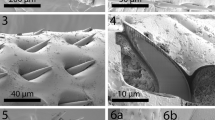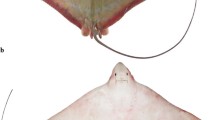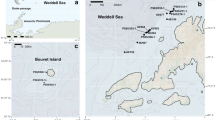Abstract
Background
Most (82%) of the 46 recognized species of Acanthogyrus (Acanthosentis) Verma and Datta, 1929 are known from Asian freshwater fishes. Only three species of Acanthosentis are known from marine or brackish water fishes from India and Pakistan. We have discovered another marine species of Acanthosentis in the Pacific Ocean, off Vietnam.
Purpose
The purpose is to describe the new species morphologically and molecularly and provide new information of its evolutionally relationships with other species of the subgenus.
Methods
Standard methods of collection and examination of marine hosts, processing and illustrating of specimens, and taxonomic identification of parasites using the extensive collection of the lead author were used. Specimens were further studied using energy-dispersive X-ray analysis and ion sectioning of hooks, SEM analysis, and molecular sequencing. Type specimens were deposited at the Harold W. Manter Lab. collection, Lincoln, Nebraska.
Results
Acanthogyrus (Acanthosentis) fusiformis n. sp. is described from the catfish, Arius sp. (Ariidae: Siluriformes) off the Pacific Coast of Vietnam at Bac Lieu in the Gulf of Thailand. The three other marine Indian species include A. (A.) arii Bilqees, 1971 which is also described from a similar catfish, Arius serratus Day off the Karachi coast in the Arabian Sea, Indian Ocean. Our new species from Vietnam is distinguished from the other 46 species by a combination of characters including a small fusiform trunk, complete circles of small hollow spines covering the entire trunk, prominent double apical organs often extending posteriorly past posterior hooks, middle and posterior hooks of equal size slightly smaller than anterior hooks, large neck continuous with the outline of the proboscis without distinct separation, big drop-shaped cephalic ganglion, extension of the proboscis receptacle anteriorly past the base of the proboscis up to the insertion point of the posterior hooks, presence of two para-receptacle structures (PRSs), free unattached thick lemnisci, short female reproductive system with filamentous attachment of the distal end of the uterine bell to the ventral body wall, and small narrowly ellipsoid eggs with thickened polar ends. Partial sequences of the 18S and internal transcribed spacers (ITS1-5.8S-ITS2) of ribosomal RNA were generated and used for phylogenetic analyses to confirm the taxonomic identity of Acanthogyrus (Acanthosentis) fusiformis n. sp.
Conclusions
We describe unique morphological features of A. fusiformis never before known in the subgenus Acanthosentis. The uniqueness of A. fusiformis is further demonstrated by its EDXA fingerprint characterized by high levels of calcium and phosphorous in hooks. The zoogeography of species of Acanthosentis is elucidated in the Indian subcontinent, the Caribbean, China, and Africa. Molecular data have been available only in few species of Acanthogyrus (Acanthosentis) to date on GenBank database. For 18S, only two sequences from unknown Acanthosentis sp. from India are available, while for the ITS1-5.8S-ITS2 region, only sequences of A. cheni from China and of two unidentified species from Malaysia are available. Additional studies of species of Acanthosentis based on morphological and molecular genetic data will be needed to reconstruct the evolutionary history and phylogenetic affinities of this group of acanthocephalans.








Similar content being viewed by others
References
Agrawal N, Singh HS (1982) A new acanthocephalan from a freshwater fish of the Gorakhpur district (India). J Adv Zool 3:85–87
Amin OM (1985) Classification. In: Crompton DWT, Nickol BB (eds) Biology of the Acanthocephala. Cambridge University Press, London, pp 27–72
Amin OM (2005) Occurrence of the subgenus Acanthosentis Verma & Datta, 1929 (Acanthocephala: Quadrigyridae) in Japan, with the description of Acanthogyrus (Acanthosentis) alternatspinus n. sp. and A. (A.) parareceptaclis n. sp. from Lake Biwa drainage fishes and a key to the species of the subgenus. Syst Parasitol 60:125–137. https://doi.org/10.1007/s11230-004-1386-5
Amin OM (2013) Classification of the Acanthocephala. Folia Parasitol 60:273–305
Amin OM, Ha NV, Ngo HD (2011) First report of Neoechinorhynchus (Acanthocephala: Neoechinorhynchidae) from marine fish (Belonidae, Clupeidae, Megalopidae, Mugilidae, Sciaenidae) in Vietnamese waters, with the description of six new species with unique anatomical structures. Parasite 18:21–34. https://doi.org/10.1051/parasite/2011181021
Amin OM, Heckmann RA, Dallarés S, Constenla M, Ha NV (2019) Morphological and molecular description of Rhadinorhynchus laterospinosus Amin, Heckmann, Ha. 2011 (Acanthocephala: Rhadinorhynchidae) from marine fish off the Pacific coast of Vietnam. Parasite 26:14. https://doi.org/10.1051/parasite/2019015
Amin OM, Heckmann RA, Halajian A, El-Naggar AM (2011) The morphology of an unique population of Corynosoma strumosum (Acanthocephala, Polymorphidae) from the Caspian seal, Pusacaspica, in the land-locked Caspian Sea using SEM, with special notes on Histopathology. Acta Parasitol 56:438–445. https://doi.org/10.2478/s11686-011-0070-6
Amin OM, Heckmann RA, Radwan NA, Mantuano JS, Alcivar MAZ (2009) Redescription of Rhadinorhynchus ornatus (Acanthocephala: Rhadinorhynchidae) from skipjack tuna, Katsuwonus pelamis, collected in the Pacific Ocean off South America, with special reference to new morphological features. J Parasitol 95:656–664. https://doi.org/10.1645/GE-1804.1
Amin OM, Heckmann RA, Sharifdini M, Albayati NY (2019) Moniliformis cryptosaudi n. sp., (Acanthocephala: Moniliformidae) from the long-eared hedgehog Hemiechinus auratus (Gmelin) (Erinaceidae) in Iraq; a case of incipient cryptic speciation related to M. Saudi in Saudi Arabia. Acta Parasitol 64:195–204. https://doi.org/10.2478/s11686-018-00021-9
Amin OM, Heckmann RA, Standing MD (2007) Structural-functional relationship of the para-receptacle structure in Acanthocephala. Comp Parasitol 74:383–387. https://doi.org/10.1654/4257.1
Amin OM, Heckmann RA, Zargar UR (2017) Description of a new quadrigyrid acanthocephalan from Kashmir, with notes on metal analysis and histology, and a key to species of the subgenus Acanthosentis from the Indian subcontinent. J Parasitol 103:458–470. https://doi.org/10.1645/17-27
Amin OM, Hendrix SS (1999) Acanthocephala of cichlids (Pisces) in Lake Malawi, Africa with a description of Acanthogyrus (Acanthosentis) malawiensis sp.n. (Quadrigyridae) from Labeo cylindricus Peters, 1852 (Cyprinidae). J Helminthol Soc Wash 66:47–55
Amin OM, Saoud MFA, Alkuwari KSR (2002) Neoechinorhynchus qatarensis sp. n. (Acanthocephala: Neoechinorhynchidae) from the blue-barred flame parrot fish, Scarus Gobban Forsskål, 1775, in Qatar waters of the Arabian Gulf. Parasitol Int 51:171–196
Anantaraman S (1980) Acanthosentis oligospinus n. sp. an acanthocephalan parasite of the brackish water fish Mystus (Macroneux) guliox in Madras. Indian J Parasitol 4:21–24
Bilqees FM (1971) Parasites of the cat fish Arius serratus. 1. Acanthocephala. Pak J Zool 3:57–65
Bilqees FM, Khan A (1987) Acanthocephala of fishes of Pakistan. Biological Bulletin of Pakistan. Monograph No. 13:1–28, Figs. 1–38
Bullock WL (1970) The zoogeography and host relations of the eoacanthocephalan parasites of fishes. Symposium on Diseases of Fishes and Shellfishes. The American Fisheries Society, Bethesda, pp 161–173
Byram JE, Fisher FM Jr (1973) The absorptive surface of Moniliformis dubius (Acanthocephala). 1. Fine structure. Tissue Cell 5:553–579
Farooqi HU, Sirikanchana P (1987) Some acanthocephalan parasites of fishes in Thailand. Thai J Agric Sci 20:97–109
Furtado JI (1963) On Acanthogyrus partispinus nov. sp. (Quadrigyridae, Acanthocephala) from Malayan cyprinid, Hampala macrolepidota Van Hasselt. Z Parasitenkd 23:219–225
Galazzo DE, Dayanandan S, Marcogliese DJ, McLaughlin JD (2002) Molecular systematics of some North American species of Diplostomum (Digenea) based on rDNA-sequence data and comparisons with European congeners. Can J Zool 80:2207–2217. https://doi.org/10.1139/z02-198
Golvan YJ (1994) Nomenclature of the Acanthocephala. Res Rev Parasitol 54:135–205
Golvan YJ (1959) Le Phylum des Acanthocephala. Deuxièmenote. La Classe de Eoacanthocephala (Van Cleave, 1936). Ann Parasitol Hum Comp 34:5–52
Heckmann RA, Amin OM, El-Naggar AM (2013) Micropores of Acanthocephala, a scanning electron microscopy study. Sci Parasitol 14:105–113
Heckmann RA, Amin OM, Radwan NAE, Standing MD, Eggett DL, El Naggar AM (2012) Fine structure and energy dispersive X-ray analysis (EDXA) of the proboscis hooks of Radinorynchus ornatus, Van Cleave 1918 (Rhadinorynchidae: Acanthocephala). Sci Parasitol 13:37–43
Heckmann RA, Amin OM, Standing MD (2007) Chemical analysis of metals in Acanthocephalans using energy dispersive X-ray analysis (EDXA, XEDS) in conjunction with a scanning electron microscope (SEM). Comp Parasitol 74:388–391. https://doi.org/10.1654/4258.1
Kimura S, Nagata Y (1992) Scientific name of Nipponbaratanago, a Japanese bitterling of the genus Rhodeus. Jpn J Ichthyol 38:425–429. https://doi.org/10.11369/jji1950.38.425
Kumar S, Stecher G, Tamura K (2016) MEGA7: molecular evolutionary genetics analysis version 7.0 for bigger datasets. Mol Biol Evol 33:1870–1874. https://doi.org/10.1093/molbev/msw054
Lee RE (1992) Scanning electron microscopy and X-ray microanalysis. Prentice Hall, Englewood Cliffs, p 458
Littlewood DTJ, Olson PD (2001) Small subunit rDNA and the phylum Platyhelminthes: signal, noise, conflict and compromise. In: Littlewood DTJ, Bray RA (eds) Interrelationships of the Platyhelminthes. Taylor Francis, London, pp 262–278
Marceniuk AP, Menezes NA (2007) Systematics of the family Ariidae (Ostariophysi, Siluriformes), with a redefinition of the genera. Zootaxa 1416:1–126
Masuda H, Amaoka K, Araga C, Uyeno T, Yoshino T (1984) The fishes of the Japanese Archipelago, vol 1. Tokai University Press, Tokyo, p 437
Milne I, Lindner D, Bayer M, Husmeier D, McGuire G, Marshall DF, Wright F (2009) TOPALi v2: a rich graphical interface for evolutionary analyses of multiple alignments on HPC clusters and multi-core desktops. Bioinformatics 25:126–127. https://doi.org/10.1093/bioinformatics/btn575
Pethiyagoda R (1991) Freshwater fishes of Sri Lanka. The Wildlife Heritage Trust of Sri Lanka, Colombo, p 362
Petrochenko VI (1956) Acanthocephala of domestic and wild animals, vol 1. Izdatelstvo Akademii Nauk SSSR, Moscow, p 435 (In Russian: English translation by Israel Program for Scientific Translations Ltd., Jerusalem, 1971, 465 pp.)
Rainboth WJ (1996) Fishes of the Cambodian Mekong. FAO species identification field guide for fishery purposes. FAO, Rome, p 265
Robins CR, Ray GC (1986) A field guide to Atlantic coastfishes of North America. Houghton Mifflin Company, Boston, p 354
Sen P (1938) On a new species of Acanthocephala Acanthosentis holospinus sp. nov. from the fish Barbus stigma (Cav. And Val.). Proc Indian Acad Sci, Bangalore 8:41–46
Standing MD, Heckmann RA (2014) Features of Acanthocephalan hooks using dual beam preparation and XEDS phase maps. Microscopy and Microanalysis Meeting: Hartford, CT. Poster. Submission Number 0383-00501
Thapar GS (1927) On Acanthogyrus n.g. from the intestine of the Indian fish Labeo rohita, with a note on the classification of the Acanthocephala. J Helminthol 5:109–120. https://doi.org/10.1017/S0022149X00018678
Thomson JM (1986) Mugilidae. In: Daget J, Gosse J, van Audenaerde DFET (eds) Check-list of the freshwater fishes of Africa (CLOFFA), vol 2. ISNB, Brussels, MRAC, Brussels, pp 344–349
Tripathi YR (1956) Studies on parasites of Indian fishes V. Acanthocephala. Rec Indian Mus 54:61–99
Verma SC, Datta MN (1929) Acanthocephala from Northern India, 1, A new genus Acanthosentis from a Calcutta fish. Ann Trop Med Parasit 23:483–500
Whitehead PJP (1985) FAO species catalogue of the clupeoid fishes of the world. An annotated and illustrated catalogue of the herrings, sardines, pilchards, sprats, shads, anchovies and wolf-herrings. Part 1- Chirocentridae, Clupeidae and Pristigasteridae. FAO Fish Synopsis (125), vol 7, Pt 1, pp 303
Whitehead PJP, Nelson GJ, Wongratana T (1988) FAO species catalogue of clupeoid fishes of the world (suborder Clupeoidei). An annotated and illustrated catalogue of the herrings, sardines, pilchards, sprats, shads, anchovies and wolf- herrings. Part 2-Engraulididae. FAO Fish Synopsis (125) vol 7, Pt 2, 579, pp 456
Whitfield PJ (1979) The biology of parasitism: an introduction to the study of associating organisms. University Park Press, Baltimore, p 277
Wright RD, Lumsden RD (1969) Ultrastructure of the tegumentary pore-canal system of the acanthocephalan Moniliformis dubius. J Parasitol 55:993–1003
Yamaguti S (1963) Systema helminthum, vol 5. Acanthocephala. Wiley Interscience, New York, p 423
Yuma M, Hosoya K, Nagata Y (1998) Distribution of freshwater fishes of Japan: an historical overview. Environ Biol Fishes 52:97–124
Acknowledgements
This project was supported by the Department of Biology, Brigham Young University (BYU), Provo, Utah, the Vietnam National Program No. 47 under Grant code VAST.DA47.12/16-19, and by an Institutional Grant from the Parasitology Center, Inc. (PCI), Scottsdale, Arizona. We thank Naomi Mortensen, Bean Museum (BYU) for preparation of the SEM plates. We would like to acknowledge the laboratory facilities provided by Department of Zoology, Chaudhary Charan Singh University, Meerut, India.
Author information
Authors and Affiliations
Corresponding author
Ethics declarations
Conflict of interest
The authors declare no conflict of interest and compliance with all relevant ethical standards.
Additional information
Publisher's Note
Springer Nature remains neutral with regard to jurisdictional claims in published maps and institutional affiliations.
Rights and permissions
About this article
Cite this article
Amin, O.M., Chaudhary, A., Heckmann, R.A. et al. The Morphological and Molecular Description of Acanthogyrus (Acanthosentis) fusiformis n. sp. (Acanthocephala: Quadrigyridae) from the Catfish Arius sp. (Ariidae) in the Pacific Ocean off Vietnam, with Notes on Zoogeography. Acta Parasit. 64, 779–796 (2019). https://doi.org/10.2478/s11686-019-00102-3
Received:
Accepted:
Published:
Issue Date:
DOI: https://doi.org/10.2478/s11686-019-00102-3




